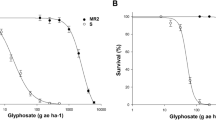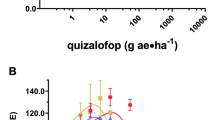Abstract
Bialaphos resistance (BAR) and phosphinothricin acetyltransferase (PAT) genes, which convey resistance to the broad-spectrum herbicide phosphinothricin (also known as glufosinate) via N-acetylation, have been globally used in basic plant research and genetically engineered crops1,2,3,4. Although early in vitro enzyme assays showed that recombinant BAR and PAT exhibit substrate preference toward phosphinothricin over the 20 proteinogenic amino acids1, indirect effects of BAR-containing transgenes in planta, including modified amino acid levels, have been seen but without the identification of their direct causes5,6. Combining metabolomics, plant genetics and biochemical approaches, we show that transgenic BAR indeed converts two plant endogenous amino acids, aminoadipate and tryptophan, to their respective N-acetylated products in several plant species. We report the crystal structures of BAR, and further delineate structural basis for its substrate selectivity and catalytic mechanism. Through structure-guided protein engineering, we generated several BAR variants that display significantly reduced non-specific activities compared with its wild-type counterpart in vivo. The transgenic expression of enzymes can result in unintended off-target metabolism arising from enzyme promiscuity. Understanding such phenomena at the mechanistic level can facilitate the design of maximally insulated systems featuring heterologously expressed enzymes.
This is a preview of subscription content, access via your institution
Access options
Access Nature and 54 other Nature Portfolio journals
Get Nature+, our best-value online-access subscription
$29.99 / 30 days
cancel any time
Subscribe to this journal
Receive 12 digital issues and online access to articles
$119.00 per year
only $9.92 per issue
Buy this article
- Purchase on Springer Link
- Instant access to full article PDF
Prices may be subject to local taxes which are calculated during checkout




Similar content being viewed by others
References
Wehrmann, A., Van Vliet, A., Opsomer, C., Botterman, J. & Schulz, A. The similarities of BAR and PAT gene products make them equally applicable for plant engineers. Nat. Biotechnol. 14, 1274–1278 (1996).
Duke, S. O. Taking stock of herbicide-resistant crops ten years after introduction. Pest. Manag. Sci. 61, 211–218 (2005).
Thompson, C. J. et al. Characterization of the herbicide-resistance gene BAR from Streptomyces hygroscopicus. EMBO J. 6, 2519–2523 (1987).
Wohlleben, W. et al. Nucleotide sequence of the phosphinothricin N-acetyltransferase gene from Streptomyces viridochromogenes Tü494 and its expression in Nicotiana tabacum. Gene 70, 25–37 (1988).
Ren, Y. F. et al. A comparative proteomics approach to detect unintended effects in transgenic Arabidopsis. J. Genet. Genomics 36, 629–639 (2009).
Brown, R. H., Raboy, V. & Bregitzer, P. Unintended consequences: high phosphinothricin acetyltransferase activity related to reduced fitness in barley. In Vitro Cell. Dev. Biol. Plant 49, 240–247 (2013).
The National Academies of Science, Engineering and Medicine Genetically Engineered Crops: Experiences and Prospects (National Academies Press, Washington DC, 2016).
Schenk, N. et al. The chlorophyllases AtCLH1 and AtCLH2 are not essential for senescence-related chlorophyll breakdown in Arabidopsis thaliana. FEBS Lett. 581, 5517–5525 (2007).
Samson, F. et al. FLAGdb/FST: a database of mapped flanking insertion sites (FSTs) of Arabidopsis thaliana T-DNA transformants. Nucleic Acids Res. 30, 94–97 (2002).
Sessions, A. et al. A high-throughput Arabidopsis reverse genetics system. Plant Cell 14, 2985–2994 (2002).
Alonso, J. M. et al. Genome-wide insertional mutagenesis of Arabidopsis thaliana. Science 301, 653–657 (2003).
Rosso, M. G. et al. An Arabidopsis thaliana T-DNA mutagenized population (GABI-Kat) for flanking sequence tag-based reverse genetics. Plant Mol. Biol. 53, 247–259 (2003).
Soudry, E., Ulitzur, S. & Gepstein, S. Accumulation and remobilization of amino acids during senescence of detached and attached leaves: in planta analysis of tryptophan levels by recombinant luminescent bacteria. J. Exp. Bot. 56, 695–702 (2005).
Hörtensteiner, S. & Feller, U. Nitrogen metabolism and remobilization during senescence. J. Exp. Bot. 53, 927–937 (2002).
Arruda, P., Kemper, E. L., Papes, F. & Leite, A. Regulation of lysine catabolism in higher plants. Trends Plant Sci. 5, 324–330 (2000).
Zhu, X., Tang, G., Granier, F., Bouchez, D. & Galili, G. A T-DNA insertion knockout of the bifunctional LYSINE-KETOGLUTARATE REDUCTASE/SACCHAROPINE DEHYDROGENASE gene elevates lysine levels in Arabidopsis seeds. Plant Physiol. 126, 1539–1545 (2001).
Vinnemeier, J., DrogeLaser, W., Pistorius, E. K. & Broer, I. Purification and partial characterization of the Streptomyces viridochromogenes Tü494 phosphinothricin-N-acetyltransferase mediating resistance to the herbicide phosphinothricin in transgenic plants. Z. Naturforsch. C. 50, 796–805 (1995).
Dyda, F., Klein, D. C. & Hickman, A. B. GCN5-related N-acetyltransferases: a structural overview. Annu. Rev. Bioph. Biom. 29, 81–103 (2000).
Vetting, M. W. et al. Structure and functions of the GNAT superfamily of acetyltransferases. Arch. Biochem. Biophys. 433, 212–226 (2005).
Srivastava, P. et al. Structural characterization of a GCN5-related N-acetyltransferase from Staphylococcus aureus. PLoS ONE 9 (2014).
Rojas, J. R. et al. Structure of Tetrahymena GCN5 bound to coenzyme A and a histone H3 peptide. Nature 401, 93–98 (1999).
Woolston, B. M., Edgar, S. & Stephanopoulos, G. Metabolic engineering: past and future. Annu. Rev. Chem. Biomol. Eng. 4, 259–288 (2013).
Weng, J. K. & Noel, J. P. The remarkable pliability and promiscuity of specialized metabolism. Cold Spring Harb. Symp. Quant. Biol. 77, 309–320 (2012).
Jin, Y.-S. et al. Chemical and biologically active constituents of Salsola collina. Chem. Nat. Compd. 47, 257–260 (2011).
Yu, P., Hegeman, A. D. & Cohen, J. D. A facile means for the identification of indolic compounds from plant tissues. Plant J. 79, 1065–1075 (2014).
Bruckhoff, V. et al. Functional characterization of CYP94-genes and identification of a novel jasmonate catabolite in flowers. PLoS ONE 11, e0159875 (2016).
Green, J. M. & Owen, M. D. Herbicide-resistant crops: utilities and limitations for herbicide-resistant weed management. J. Agric. Food Chem. 59, 5819–5829 (2011).
Herouet, C. et al. Safety evaluation of the phosphinothricin acetyltransferase proteins encoded by the PAT and BAR sequences that confer tolerance to glufosinate-ammonium herbicide in transgenic plants. Regul. Toxicol. Pharm. 41, 134–149 (2005).
Dan, Y. Plant Transformation Technology Revolution in Last Three Decades: Historical Technology Developments (Bentham Science Publishers, Sharjah, 2012).
Song, W. Y. & Choi, K. S. Alexis de, A., Martinoia, E. & Lee, Y. Brassica juncea plant cadmium resistance 1 protein (BjPCR1) facilitates the radial transport of calcium in the root. Proc. Natl Acad. Sci. USA 108, 19808–19813 (2011).
Foetzki, A. et al. Surveying of pollen-mediated crop-to-crop gene flow from a wheat field trial as a biosafety measure. GM Crops Food 3, 115–122 (2012).
Czechowski, T., Stitt, M., Altmann, T., Udvardi, M. K. & Scheible, W. R. Genome-wide identification and testing of superior reference genes for transcript normalization in Arabidopsis. Plant Physiol. 139, 5–17 (2005).
Chambers, M. C. et al. A cross-platform toolkit for mass spectrometry and proteomics. Nat. Biotechnol. 30, 918–920 (2012).
Gowda, H. et al. Interactive XCMS Online: simplifying advanced metabolomic data processing and subsequent statistical analyses. Anal. Chem. 86, 6931–6939 (2014).
Smith, C. A. et al. METLIN: a metabolite mass spectral database. Ther. Drug Monit. 27, 747–751 (2005).
Tropea, J. E., Cherry, S. & Waugh, D. S. Expression and purification of soluble His(6)-tagged TEV protease. Methods Mol. Biol. 498, 297–307 (2009).
Battye, T. G., Kontogiannis, L., Johnson, O., Powell, H. R. & Leslie, A. G. iMOSFLM: a new graphical interface for diffraction-image processing with MOSFLM. Acta Crystallogr. D 67, 271–281 (2011).
Evans, P. Scaling and assessment of data quality. Acta Crystallogr. D 62, 72–82 (2006).
Adams, P. D. et al. PHENIX: a comprehensive Python-based system for macromolecular structure solution. Acta Crystallogr. D 66, 213–221 (2010).
Emsley, P. & Cowtan, K. Coot: model-building tools for molecular graphics. Acta Crystallogr. D 60, 2126–2132 (2004).
Goldstein, A. L. & McCusker, J. H. Three new dominant drug resistance cassettes for gene disruption in Saccharomyces cerevisiae. Yeast 15, 1541–1553 (1999).
Engler, C. et al. A Golden Gate modular cloning toolbox for plants. ACS Synth. Biol. (2014).
Clough, S. J. & Bent, A. F. Floral dip: a simplified method for Agrobacterium-mediated transformation of Arabidopsis thaliana. Plant J. 16, 735–743 (1998).
Schelbert, S. et al. Pheophytin pheophorbide hydrolase (pheophytinase) is involved in chlorophyll breakdown during leaf senescence in Arabidopsis. Plant Cell 21, 767–785 (2009).
Christ, B. et al. MES16, a member of the methylesterase protein family, specifically demethylates fluorescent chlorophyll catabolites during chlorophyll breakdown in Arabidopsis. Plant Physiol. 158, 628–641 (2012).
Guyer, L. Characterization of Dephytylation and Dechelation, Two Early Steps of Chlorophyll Breakdown in Leaves and Fruits. PhD thesis, Univ. Zurich (2015).
Christ, B. et al. Cytochrome P450 CYP89A9 is involved in the formation of major chlorophyll catabolites during leaf senescence in Arabidopsis. Plant Cell 25, 1868–1880 (2013).
Perez-Perez, J. M. et al. Functional redundancy and divergence within the Arabidopsis RETICULATA-RELATED gene family. Plant Physiol. 162, 589–603 (2013).
Christ, B. Chlorophyll Breakdown: Modifications of Colorless Chlorophyll Catabolites. PhD thesis, Univ. Zurich (2013).
Zufferey, M. et al. The novel chloroplast outer membrane kinase KOC1 is a required component of the plastid protein import machinery. J. Biol. Chem. 292, 6952–6964 (2017).
Pulido, P., Llamas, E. & Rodriguez-Concepcion, M. Both Hsp70 chaperone and Clp protease plastidial systems are required for protection against oxidative stress. Plant Signal. Behav. 12, e1290039 (2017).
Waterhouse, A. M., Procter, J. B., Martin, D. M., Clamp, M. & Barton, G. J. Jalview Version 2 – a multiple sequence alignment editor and analysis workbench. Bioinformatics 25, 1189–1191 (2009).
Acknowledgements
We thank D.M. Sabatini, G.R. Fink, N. Amrhein and E. Martinoia for helpful discussions. We thank J.M. Cheeseman for providing the phosphinothricin-resistant Glycine max line. We thank J. Varberg for providing the phosphinothricin-resistant B. napus line and M. Rahman for providing conventional B. napus lines. This work is based on research conducted at the Northeastern Collaborative Access Team (NE-CAT) beamlines, which are funded by the National Institute of General Medical Sciences from the National Institutes of Health (P41 GM103403). The Pilatus 6 M detector on NE-CAT 24-ID-C beam line is funded by a NIH-ORIP HEI grant (S10 RR029205). This research used resources of the Advanced Photon Source, a US Department of Energy (DOE) Office of Science User Facility operated for the DOE Office of Science by Argonne National Laboratory under Contract No. DE-AC02-06CH11357. This work was supported by the Swiss National Science Foundation (grant 31003A_149389 to S.H. and postdoctoral fellowship P2ZHP3_155258 to B.C.), the EU-funded Plant Fellows program (S.A.), the Pew Scholar Program in the Biomedical Sciences (J.K.W.) and the Searle Scholars Program (J.K.W.).
Author information
Authors and Affiliations
Contributions
B.C., S.A., S.H. and J.K.W. designed experiments; B.C., R.H., L.G., R.F. and S.A. performed experiments; B.C., R.H., L.G. and J.K.W. analysed data; B.C., S.H., S.A. and J.K.W. wrote the manuscript.
Corresponding authors
Ethics declarations
Competing interests
B.C. and J.K.W. have filed a patent application on BAR and PAT mutants described in this paper that show altered acetyltransferase activity.
Additional information
Publisher’s note: Springer Nature remains neutral with regard to jurisdictional claims in published maps and institutional affiliations.
Electronic supplementary material
Supplementary Information
Supplementary Tables 1–3, Supplementary Figures 1–17
Rights and permissions
About this article
Cite this article
Christ, B., Hochstrasser, R., Guyer, L. et al. Non-specific activities of the major herbicide-resistance gene BAR . Nature Plants 3, 937–945 (2017). https://doi.org/10.1038/s41477-017-0061-1
Received:
Accepted:
Published:
Issue Date:
DOI: https://doi.org/10.1038/s41477-017-0061-1
This article is cited by
-
The potential of metabolomics in assessing global compositional changes resulting from the application of CRISPR/Cas9 technologies
Transgenic Research (2023)
-
Recent advances in proteomics and metabolomics in plants
Molecular Horticulture (2022)
-
Evaluation of the use of untargeted metabolomics in the safety assessment of genetically modified crops
Metabolomics (2020)
-
Negligible transcriptome and metabolome alterations in RNAi insecticidal maize against Monolepta hieroglyphica
Plant Cell Reports (2020)
-
Repeated evolution of cytochrome P450-mediated spiroketal steroid biosynthesis in plants
Nature Communications (2019)



